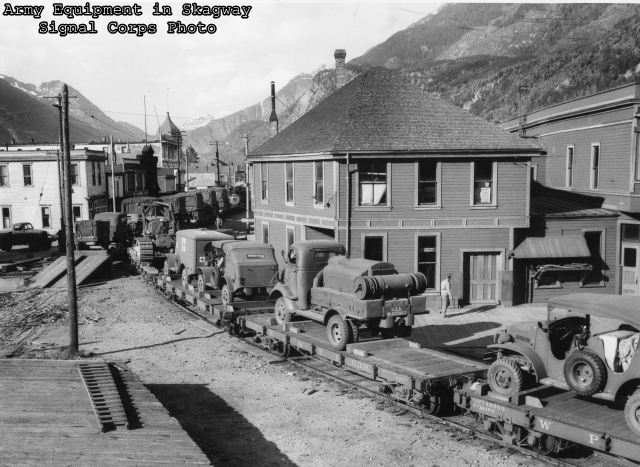Life in tiny Skagway developed a routine during the first forty years of the century.
From mid-June through August, Steamships loaded with tourists piled into the harbor three to four times a week. A sheer rock cliff bordered the dock where they tied up, and it was covered with painted emblems, each representing a ship’s maiden voyage from Skagway. Among the ship emblems, a white skull represented Soapy Smith, the most famous con man and gangster of the Gold Rush days.
Trains ran daily from the Skagway station to Lake Bennett, Carcross and on to Whitehorse.
After mid-September, the ships came less frequently. Trains ran only two to three times a week and snow drifts blanketed the tracks. Mail to Skagway that came almost daily during summer came only twice a month in the winter. The little town entered a period of almost total isolation, supporting and entertaining each other through the long winters until the outside world returned in June.
The white citizens of Skagway shared their space, if not their social and economic world, with one hundred or so First Nations of the Tlingit tribe. Their forebears had inhabited the islands, bays and river mouths of the long inlet from the Pacific that would be called the Lynn Canal for centuries. To the white citizens of Skagway, the Tlingit’s rich and sophisticated culture and their complex social organization were invisible.
Acquaintance, even friendship, occurred between whites and Tlingits, but they ended at the front door. Tlingits watched movies at the Tropea family’s theater, but only from the balcony. Not part of the Skagway community, Tlingits were not welcome at community social events. White’s referred to natives as “Siwash”, a hurtful ethnic pejorative that vividly expressed contempt for the Indians and everything about them.
Life for Tlingits in Skagway resembled, in many ways, life for Blacks in Southern Louisiana. Louisiana, of course, had codified the rules in a system of Jim Crow laws where in Alaska they were a matter of custom. But the effects were similar—a fact that didn’t escape the black troops of the Corps when they arrived in country.
The unique and isolated little town made its way through the decades, mostly oblivious to the outside world and its doings. Its residents barely noticed when the outside world exploded into war in December 1941.
They noticed when the Corps of Engineers brought the war to their doorstep in 1942.
